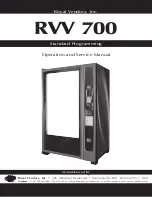
Page 5 of 10 | 20180626
User Manual:
15 Gallon Battery-Powered Portable Foam Unit | English
READ ALL INSTRUCTIONS BEFORE OPERATING EQUIPMENT
Model Number: FI-BP-15N, FI-BP-15NK, FI-BP-15NV AND RELATED UNITS
BATTERY TROUBLESHOOTING GUIDE
PROBLEM
CAUSE
SOLUTION
Power light will not turn on
• Blown fuse
• Replace fuse (FU40-ATO)
• Battery leads are backwards or
disconnected
• Connect leads to correct terminals
Power switch light will not
stop blinking
• Depleted battery
• Completely recharge battery
• Bad battery
• Replace battery (BSLA-12V55)
• Bad control relay
• Replace control relay (LVRC-12V-40F)
Power switch light is on but
unit is not running (when
it has previously been
operating)
• Unit overheating from extended use
• Turn unit off and let cool at least 1 hour
Battery will not completely
charge
• Bad battery
• Replace battery (BSLA-12V55)
• Bad charger
• Replace charger (BC12V-NC72) or charing port (BCP12V)
Battery discharges too
quickly
• Battery was stored in depleted state
for long periods of time
• Replace battery (BSLA-12V55)
• Battery has reached life expectancy
• Replace battery (BSLA-12V55)
• Battery was charged and run for short
periods of time (not allowed to fully
charge or discharge)
• Replace battery (BSLA-12V55)
Best Charging Practices:
• Make sure you are using a charger that provides the
proper voltage for your battery.
• Do not speed up charging time or increase voltage for a
fast charge. This will result in overcharging the battery.
Batteries that are overcharged will over heat. Excessive
heat can destroy a battery in as little as a few hours.
Overcharging kills batteries.
• Do not use a lower charging voltage than required for
your battery. By doing so, the battery will never be
fully charged. Undercharging leads to reduced capacity
creating a battery that needs to work harder than fully
charged batteries. Undercharging and overworking leads
to shortened battery life.
Best Maintenance Practice:
• For maximum battery life and performance, batteries
should be recharged as soon as possible after each use.
Batteries should be stored in a fully charged state. Storing
in a discharged state will kill the battery.
• Disconnect the charger after the battery has been fully
charged. Continuous over charging or under charging is
the worst thing for a SLA battery.
• Check the battery terminals for corrosion and/or battery
deformation. A deformed battery or corrosion on the
terminals is subject to failure.
Troubleshooting Instructions:
• Check to ensure the discharge hose is uncoiled properly,
and that there are no kinks that could obstruct fluid flow.
• If needle valve (NV18) valve is open too far, the pump
(P56/P56K/P56V) will cycle improperly due to lack of air
pressure. If this occurs, reset needle valve as described in
Operation Instruction #4.
• Make sure proper foaming chemical and concentration is
being used.
• If air passes through the pump (P56/P56K/P56V) without
cycling, the pump needs to be replaced.
• If foam comes out wet, no matter where the needle valve
(NV18) is positioned, the check valve (CV14QF) may need
to be replaced.
• Check for plugged strainer (STR38-IL). Replace strainer if
necessary. Strainer must be used.
• Check the mixing material (MIX2) by removing the SMQC-
FT to acess the mixing material. If the mixing material
has a lot of foreign particles in it, make sure the strainer
(STR38-IL) is still in place. Clean and replace mixing
material.
WARNING




























